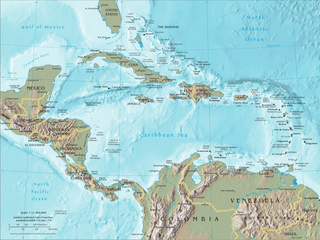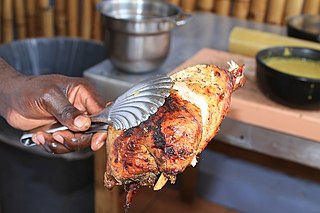Related Research Articles

Barbecue or barbeque is a term used with significant regional and national variations to describe various cooking methods that use live fire and smoke to cook the food. The term is also generally applied to the devices associated with those methods, the broader cuisines that these methods produce, and the meals or gatherings at which this style of food is cooked and served. The cooking methods associated with barbecuing vary significantly but most involve outdoor cooking.

Buccaneers were a kind of privateers or free sailors particular to the Caribbean Sea during the 17th and 18th centuries. First established on northern Hispaniola as early as 1625, their heyday was from the Restoration in 1660 until about 1688, during a time when governments were not strong enough and did not consistently attempt to suppress them.

Head cheese or brawn is a cold cut terrine or meat jelly that originated in Europe. It is made with flesh from the head of a calf or pig, typically set in aspic, and usually eaten cold, at room temperature, or in a sandwich. Despite its name the dish is not a cheese and contains no dairy products. The parts of the head used vary, and may include the tongue and sometimes the feet and heart but do not commonly include the brain, eyes or ears. Trimmings from more commonly eaten cuts of pork and veal are often used, with gelatin added as a binder.

The era of piracy in the Caribbean began in the 1500s and phased out in the 1830s after the navies of the nations of Western Europe and North America with colonies in the Caribbean began combating pirates. The period during which pirates were most successful was from the 1660s to 1730s. Piracy flourished in the Caribbean because of the existence of pirate seaports such as Port Royal in Jamaica, Tortuga in Haiti, and Nassau in the Bahamas. Piracy in the Caribbean was part of a larger historical phenomenon of piracy, as it existed close to major trade and exploration routes in almost all the five oceans.

Port Royal is a village located at the end of the Palisadoes, at the mouth of Kingston Harbour, in southeastern Jamaica. Founded in 1494 by the Spanish, it was once the largest city in the Caribbean, functioning as the centre of shipping and commerce in the Caribbean Sea by the latter half of the 17th century. It was destroyed by an earthquake on 7 June 1692, which had an accompanying tsunami, leading to the establishment of Kingston, which is now the largest city in Jamaica. Severe hurricanes have regularly damaged the area. Another severe earthquake occurred in 1907.

A cutlass is a short, broad sabre or slashing sword, with a straight or slightly curved blade sharpened on the cutting edge, and a hilt often featuring a solid cupped or basket-shaped guard. It was a common naval weapon during the early Age of Sail.

Corsairs were privateers, authorized to conduct raids on shipping of a nation at war with France, on behalf of the French crown. Seized vessels and cargo were sold at auction, with the corsair captain entitled to a portion of the proceeds. Although not French Navy personnel, corsairs were considered legitimate combatants in France, provided the commanding officer of the vessel was in possession of a valid letter of marque, and the officers and crew conducted themselves according to contemporary admiralty law. By acting on behalf of the French Crown, if captured by the enemy, they could in principle claim treatment as prisoners of war, instead of being considered pirates. Because corsairs gained a swashbuckling reputation, the word "corsair" is also used generically as a more romantic or flamboyant way of referring to privateers, or even to pirates. The Barbary pirates of North Africa as well as the Ottoman Empire were sometimes called "Turkish corsairs".

Haematoxylum campechianum is a species of flowering tree in the legume family, Fabaceae, that is native to southern Mexico,where it is known as Árbol de campeche, and introduced to the Caribbean, northern Central America, and other localities around the world. The tree was of great economic importance from the 17th century to the 19th century, when it was commonly logged and exported to Europe for use in dyeing fabrics. The modern nation of Belize developed from 17th- and 18th-century logging camps established by the English. The tree's scientific name means "bloodwood".

Tortuga Island is a Caribbean island that forms part of Haiti, off the northwest coast of Hispaniola. It constitutes the commune of Île de la Tortue in the Port-de-Paix arrondissement of the Nord-Ouest department of Haiti.

During the Spanish colonization of the Americas, the Spanish Main was the collective term for the parts of the Spanish Empire that were on the mainland of the Americas and had coastlines on the Caribbean Sea or Gulf of Mexico. The term was used to distinguish those regions from the numerous islands Spain controlled in the Caribbean, which were known as the Spanish West Indies.

Jerk is a style of cooking native to Jamaica, in which meat is dry-rubbed or wet marinated with a hot spice mixture called Jamaican jerk spice.
Clogging is a type of folk dance practiced in the United States, in which the dancer's footwear is used percussively by striking the heel, the toe, or both against a floor or each other to create audible rhythms, usually to the downbeat with the heel keeping the rhythm.

The Golden Age of Piracy is a common designation for the period between the 1650s and the 1730s, when maritime piracy was a significant factor in the histories of the Caribbean, the United Kingdom, the Indian Ocean, North America, and West Africa.
Salmagundi is a cold dish or salad made from different ingredients which may include meat, seafood, eggs, cooked vegetables, raw vegetables, fruits or pickles. In English culture, the term does not refer to a single recipe but describes the grand presentation of a large plated salad of many disparate ingredients. These can be arranged in layers or geometrical designs on a plate or mixed. The ingredients are then drizzled with a dressing. The dish includes a wide range of flavours and colours and textures on a single plate. Often recipes allow the cook to add various ingredients which may be available at hand, producing many variations of the dish. Flowers from broom and sweet violet were often used.

Roche Braziliano was a Dutch pirate born in the town of Groningen. His pirate career lasted from 1654 until his disappearance around 1671. He was first made famous in Alexandre Exquemelin's 1678 book The Buccaneers of America; Exquemelin did not know Braziliano's real name, but historians have found he was probably born as Gerrit Gerritszoon and that he and his parents moved to Dutch-controlled Brazil. He is known as "Roche Braziliano", which in English translates to "Rock the Brazilian", due to his long exile in Brazil.

Haitian cuisine consists of cooking traditions and practices from Haiti. It is a Creole cuisine that originates from a blend of several culinary styles that populated the western portion of the island of Hispaniola, namely the African, French, indigenous Taíno, Spanish and Arab influence. Haitian cuisine is comparable to that of "criollo" cooking and similar to the rest of the Latin Caribbean, but differs in several ways from its regional counterparts.
White Haitians, also known as Euro-Haitians, are Haitians of predominant or full European descent.

Gammon is the hind leg of pork after it has been cured by dry-salting or brining, which may or may not be smoked. Strictly speaking, a gammon is the bottom end of a whole side of bacon, ham is just the back leg cured on its own. Like bacon, it must be cooked before it can be eaten; in that sense gammon is comparable to fresh pork meat, and different from dry-cured ham like prosciutto. The term is mostly used in the United Kingdom and Ireland, while other dialects of English largely make no distinction between gammon and ham.

The Sack of Campeche was a 1663 raid by pirates led by Christopher Myngs and Edward Mansvelt which became a model for later coastal pirate raids of the buccaneering era.

Michel le Basque was a pirate and flibustier from the Kingdom of Navarre in the southwest of France. He is best known as a companion of François L'Olonnais, with whom he sacked Maracaibo and Gibraltar.
References
- 1 2 Diccionario de Etimologías
- ↑ Oxford English Dictionary
- ↑ The Buccaneer's Realm: Pirate Life on the Spanish Main, 1674-1688 by Benerson Little (Potomac Books, 2007)
